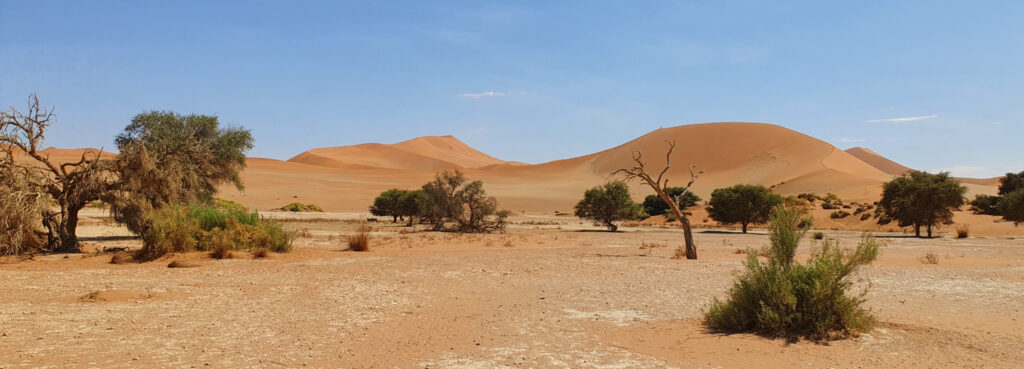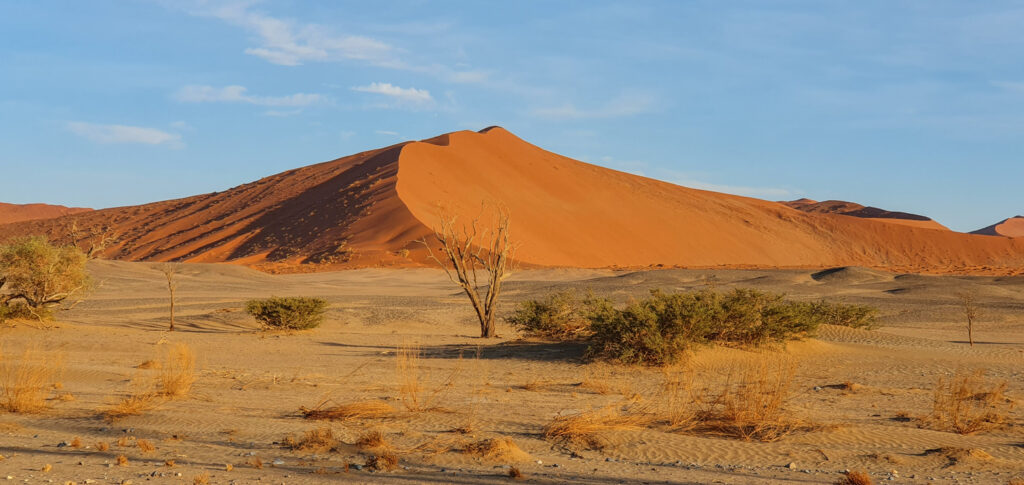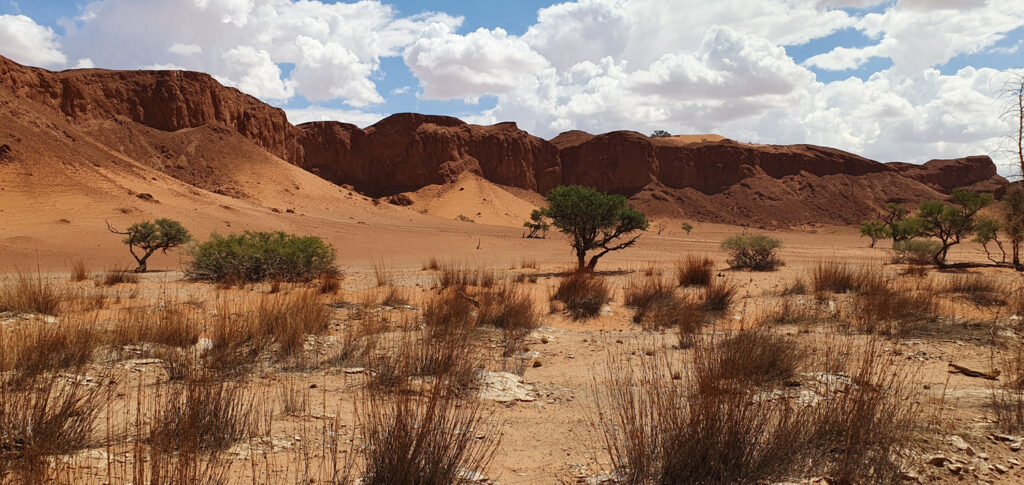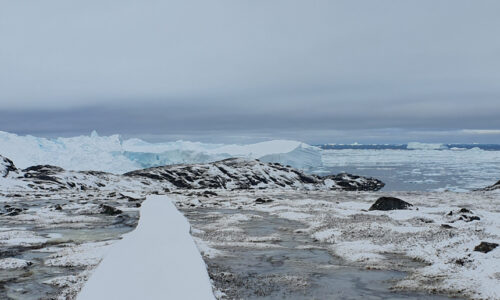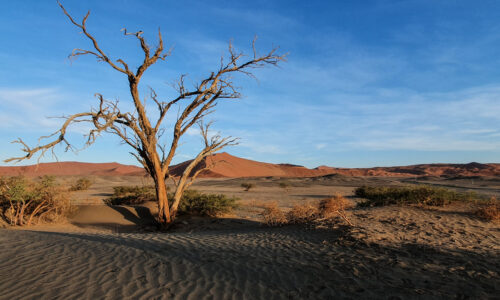Preparations for the trip to Namibia

Being someone who does not shy away from the colder regions, and basically thrives in such conditions, I surprised even myself with this one. It was the time to see the african continent. I have been listening for ages about my friends’ trips to Egypt, Tunis, Morocco etc., but my plan was to cross the equatorial line. Due to the fact that places such as Namibia are way out of my comfort zone, in order to reach and make that zone comfortable I had to do research about the risks, the dangers they pose and how to turn them to play in my favor in case of any escalation.
The main focus of this trip was spending time in the oldest desert in the entire world – Namib desert. I am incredibly fascinated by vast empty spaces, and the opportunity to walk through them does something to me. In order to enjoy it, here are the topics which are required to be covered, as everything revolves around that. This was another type of extreme environment, no less unforgiving compared to the cold arctic one.
Dehydration risk and how to prevent it?
The biggest risk of the entire trip, considering the amount of planned walks/hikes/treks by far is the dehydration due to the exposure to the elements. Not the wildlife.
The ability to recognize dehydration early is crucial, especially in Namibia’s dry climate.
Here are the key signs I have learned to watch for (all of them are very intuitive and well known, but it is very good to remind yourself of such occurrences before you immerse yourself in an arid place with limited help):
Mild dehydration
- Thirst – feeling thirsty is the first sign (d-uh)
- Dry mouth & lips – lack of saliva, sticky feeling in the mouth.
Moderate dehydration
- Dark yellow urine – healthy urine should be light yellow; darker means dehydration.
- Less frequent urination – if you haven’t urinated in a few hours, you need more water.
- Fatigue or dizziness – feeling weak, lightheaded, or having trouble focusing.
- Headache – a common sign, which becomes worsened by sun exposure.
Severe dehydration
- Rapid heartbeat & breathing – your body is struggling to circulate blood.
- Sunken eyes & dry skin – skin loses elasticity; eyes may look hollow.
- Confusion or irritability – if you feel disoriented, you need immediate hydration.
- No sweating – in extreme cases, the body stops sweating to conserve water.
- Fainting or heat exhaustion symptoms – a serious sign of dehydration and overheating.
Preventing all these issues can be summarized to this: carry water, drink before you get thirsty, often and in small sips, think: electrolytes. If you feel strong thirst – you are already way too late.
According to my weight, activity level and the surroundings it is expected to evaporate 0,5-0.8L of sweat per hour. This means that it is extremely irresponsible to venture out with less than 5 liters of water. I am very well aware that this means extra 5 kg on my back but the weight decreases as the day goes on. And with it, the risk of basically losing consciousness in the worst possible environment.
It is also pragmatic not to think you can rely on places which can sell you water, or even villages in which you’d hypothetically ask someone for water. In countries which are famous for low population, to expect such stuff is very optimistic. And even the occasional water sources on the ground are far from something which is recommended to use.
Heat stroke
Dehydration can be followed by a heat stroke. Sounds horrid and extremely dangerous, when you are alone in the desert with restricted resources, especially by yourself. Planning activities outside the peak radiation and extreme sunlight, especially if you are going on hikes and in places without shade is very important.
Wearing light colored clothes made of breathable fabrics helps. Pro tip: I discovered that linen does not work at all for this, at least for me; trousers made of viscose/cotton blend which were very light and flowy did wonders on the other hand.
Starvation
Even though I eat extremely sparsely when I go on my walks, I need to be aware of the possible places to eat – if they even exist – or to plan thoroughly the quantities and quality of the food which gets to occupy the space in a relatively small backpack. There is no space for mistakes, unnecessary products or whatnot, and nothing I carry can be brought back to the basecamp. There is only a bag of nuts or a piece of fruit in the bag, the rest are the cameras, drone and as much water as I am able to pack.
Getting lost
The idea of walking off the path between the dunes, losing the idea where I am and then circling these giants in hope I’ll somehow find the direction is very scary for me. Especially combined with the aforementioned symptoms of severe dehydration. This is why I came to Namib desert fully prepared, with my planned paths knowing by heart, and consequently understanding at every moment where I am.
It is very easy to become disoriented in a seemingly bleak environment, so preparing yourself by checking maps, hiking trails, physical paper maps and having a compass is a must.
Encounters with wildlife
Ahhh… my favorite subject.
Being someone who truly loves and respects nature and all of its quirks, including the venomous animals who can off me in a second, I was extremely excited by the idea of seeing a random animal crossing my path.
I have no fears of animals and I always tend to see how to approach a previously unknown creature instead of running away from it or, even worse, trying to kill it. Also, I take time to get to know the types of animals which I can maybe stumble upon, their threat level and the danger they might pose on my functionality.
There are a lot of venomous species of snakes and scorpions which I might have encountered. Luckily for me, the chances of such moments are very low as the animals tend to avoid any sort of contact with us, and will charge only if they are feeling attacked or cornered. Some of them are truly terrifyingly dangerous and being afflicted by their venom would really have a serious impact on my health. Knowing when they are active, which sort of terrain they prefer, how the weather conditions affect the chances of us meeting and being able to recognize the critical species’ plays a major role in getting the best possible outcome with such creatures.
Cold exposures
The deserts are famous for being ruthlessly warm and arid during the day, and quite the opposite when the Sun goes down. This environment, due to this fact, changes entirely when the darkness comes. Lack of warmth can cause the temperature to drop to zero in certain areas and seasons, so planning to be active during the night demands extra layers.
I did not do that. My plan was to enter the room every evening ca 19-20 and rest, while preparing for the next planned day’s activities. My daily activities stopped when it was not possible to take a proper photo.
Sun up / sundown
Before I venture out to an unknown location I make sure I know when the Sun comes out and goes down. This is the time span that I have on my disposal as it gives visibility and the ability to explore and take pictures. At the beginning of March the Sun comes out at around 7 AM and goes down at 19:30, which gave me roughly 12 and a half hrs of sunlight every day. Approx 30 min before 7 AM and 30 min before the pitch black darkness arrives there is a beautiful light with rich iron oxide color of the sand to be adored.
This short day scheme feels very strange being someone living in Norway, and used to having an extreme daylength during the summer season; I was waking up at my regular hours (around 4 AM) in the pitch dark surroundings. Understanding how unpredictable the wildlife could be and how limited I was in terms of emergency and help, I did a few short walks just to feed the curiosity and ended up being rewarded by meeting a small jackal, but nothing beyond the safety lines.
Personal safety
Research showed that I would be quite safe, being a solo woman, particularly of the I-walk-a-lot-across-the-wilderness type. This turned out to be very true as I had the opportunity to be entirely unbothered by anyone while walking, or even if an encounter happened, I would not feel threatened in any way but supported and able to rely in case something goes awry.
Also, Namibia does not have internal or international acute conflicts. The last ones were active over 25 years ago, and since then, Namibia is considered to be very peaceful and conflict free; one of the safest on the entire continent.
Vaccination
Before the trip I did a research regarding the needed vaccines for Namibia. I got several shots with incredibly deranged viral diseases which would make my life a mother of all living hells if I ended up contracting them. The shots were fired by a very nice lady in the health station near me. It would be even more if I was heading for the green area of Namibia (Etosha, Caprivi etc) which demands anti-malaria vaccines, but this was not my intention. My goal was only the dry area – Namib desert.
Understanding distances
I always think of the worst. Not first ![]() and certainly not only of the worst, but I like to imagine the worst case scenario in my mind and crunch out how I would respond in a critical situation.
and certainly not only of the worst, but I like to imagine the worst case scenario in my mind and crunch out how I would respond in a critical situation.
Knowing where you are and how far the nearest house with a human is helps a lot. Knowing where the nearest hospital is could be a matter of life or death. Venturing through the desert wilderness with everything mentioned above demands such understanding of distances, time needed to reach help, and in the end hope you would not be needing it.
